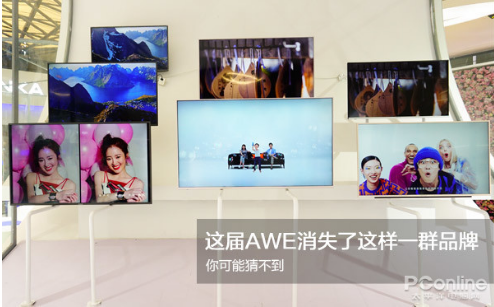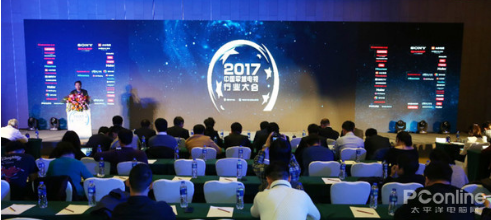If you compare last year and this year's AWE exhibition vertically, what makes people feel most chilling is not the absence of Samsung's booth, but the disappearance of a large number of Internet brands. The only representative left of AWE2018 Internet TV is Storm. At this moment last year, Xiaomi, Micro Whale, Kanshang, and PPTV are the moments when Internet TV brands are making great strides. They misfired collectively this year, which inevitably makes people feel sad. After all, the credit for breaking the price monopoly and stimulating the growth of content has to be crowned by these enthusiastic Internet TV heads. But the history of radicals falling into cannon fodder is often staged, and they are no exception. According to data released by the 2017 (13th) China Flat TV Industry Conference, the overall share of Internet TV brands in 2017 has fallen to 10%. In mid-2016, this figure was once as high as about 20%. The one that fell first, and has to be mentioned again, is LeEco. It made a good start, but ended up in a dying. The rupture of the capital chain directly damaged LeTV’s seven major ecosystems, leading to a series of chain reactions such as debt disputes, judicial freezing of assets, reform and reorganization, and business sales. Boss Jia was forced to hide in the United States to dream of building a car, and was twice included in the list of dishonest persons for execution. However, the latest news shows that LeTV has gained 48% cumulatively in 15 trading days starting from the closing price of 4.16 yuan on February 13th. This is probably the stimulation of Jia Yueting's tweet about Faraday the day before? Or is Faraday Future's affiliate company Rui Chi Smart Car set up in Guangzhou? But although there is speculative funds to buy, if there is no long-term support from performance, growth and beyond-expected factors, the surge of oversold stocks, including LeTV, will only be short-lived. LeEco’s ominous signs are like a butterfly in the tropical rainforest of the Amazon River Basin in South America. Occasionally flapping its wings can cause a tornado in Texas in a few weeks. Internet brands like Kanshang, PPTV, and Fengxing, which were originally not good at vocalizing, have long been swept into the ocean of arrogance by this tornado. It was exposed by internal employees that "Forcing employees to quit without paying wages" for Watch TV; Fengxing TV was also in the quagmire of sales fraud, with only 1 million units sold in two years. After LeTV collapsed, many media turned their focus to the same video-originated storm. Whenever the LeTV crisis hits, in addition to the Leshi potato chips, it is the Storm Group. The development of the two has too many similarities, and they have been criticized by the industry as the "next LeTV", and they can't get rid of the "shrink Version of LeTV" label. The difference is that the financing scale of LeTV Empire built by Jia Yueting is close to 100 billion, while the financing scale of Baofeng Group is simply "not worth mentioning"! Only 1.486 billion yuan, less than 1.5 billion yuan. In the financing structure, more than 60% of LeEco’s financing was debt financing; and out of Baofeng’s 1.486 billion financing, only 369 million was debt financing. Even if the financing fails, the storm Group's splashes in society are limited. At this moment, the traditional color TV brands are also awakening, Internet TV is like a clown in their eyes, and they can see through it at a glance. Although Internet TV has directly stirred up the market with the banner of "content is king", Internet manufacturers' brands have continued throughout the year, and marketing battles have continued to depress the price of the TV market time and time again. But how can traditional TV companies with money and hardware capabilities sit still and launch sub-brands-Konka KKTV, Skyworth Coocaa, Changhong CHiQ TV, Hisense VIDAA, TCL Thunderbird, etc., to fight back against Internet brands squeezing prices. To some extent, Internet TV has rewritten the rules of the entire TV industry. However, after several years of rapid development of Internet TV, its own bottlenecks have also been exposed. Many Internet TV manufacturers have proposed to sell hardware through subsidies and then profit from content. A necessary prerequisite for the success of low-cost hardware or even free hardware is that the continuous investment of funds has also led to the inability to tilt funds to technology research and development, which will eventually damage the user’s viewing experience. This is why many Internet TVs are in The selling point of the promotion has been to avoid the picture quality and sound quality. In addition, whether it is self-made content or outsourcing copyright, it is not in the hands of TV brands and can only be purchased from content providers. The construction of its content ecology also requires a lot of funds. Therefore, the major Internet TV companies began to look for the thighs and the rich, but they did not have enough funds to burn, and they couldn't afford it. To PPTV to take refuge in Suning, the microwhale hugs Ali's thighs, and the abandoned barley and other TV brands are destined to be eliminated. Obviously, whether it is cost-effective, or the definition of user scenarios in smart homes, traditional manufacturers are more experienced. The panel price increase event is a watershed. Internet TV, which focuses on cost-effectiveness, will not be able to breathe after this. However, the traditional brand's certain inventory has become an advantage in the price war. Later, the concept of artificial intelligence scoured the TV industry, and traditional brands have more clearly defined user scenarios in their operations for many years. The overall sales volume also determines the capabilities of big data. The sales volume of Internet TV is not in the same order as traditional brands when it is the hottest. The direction of content operation, no matter which brand of TV carries, is handed over to more professional content operators or video vertical websites. The packaging of programs that brands can do is also convergent in most cases. Three years ago, traditional brands panicked in the face of crossovers' aggressive marketing, thinking that the entire industry was about to be subverted, but in a blink of an eye, the subversives had long been wiped out in the capital. Compared with Internet TV, traditional color TVs can be described as rich and powerful, with hardware strength. Based on the strength of picture and sound quality, they have begun to cooperate with multiple video content providers. Both hardware configuration and content resources are superior to Internet TV brands. With complete offline sales channels, Internet TV manufacturers can be said to have lost groundlessly. On the contrary, in addition to launching Internet sub-brands, traditional brands have flourished in terms of technological breakthroughs and overseas expansion. In 2016, Sharp married the Hon Hai giants. From brand operation to channel control, Sharp is under the sole control of Foxconn. Sharp, which was taken over by Foxconn, succeeded in re-bigging this dwindling brand in 2017, relying on 8K display and other technologies to bring it back to the top of the black power industry. Hisense, which has always been committed to expanding overseas markets, had an unhappy relationship with Sharp but successfully took Toshiba home for 12.9 billion yen, or about 754 million yuan. Hisense has an additional "market entry point", and Directly get the "third place" share of the Japanese market. Summary: In 2018, Internet TV has moved from "fickle" to "late twilight", because their fickle tactics have been quickly imitated by traditional brands, and they have rapidly expanded the market for inclusion under the effect of scale. If Internet TV wants to continue to survive, to penetrate such an extremely mature market, and to break the strong contract between the interests, it also needs to maintain the characteristics of constant change. Then, in 2018, it seems that they have not changed.
Copper substrate is the most expensive metal substrate, and its thermal conductivity is many times better than that of aluminum substrate and iron substrate. It is suitable for high-frequency circuits, areas with large changes in high and low temperature, and the heat dissipation and architectural decoration industries of precision communication equipment. The copper substrate circuit layer has great current carrying capacity and thermal aging resistance.
Heavy Copper PCB,Board Metal Substrate,Copper Substrate,Thermal Conductivity of Copper Board,Aluminum PCB Thermal Conductivity Huizhou Liandajin Electronic Co., Ltd , https://www.ldjpcb.com

